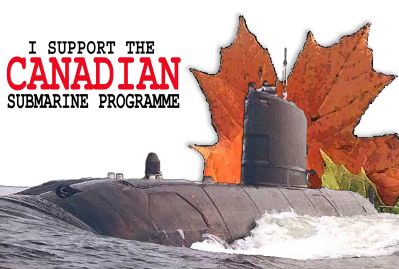
Ad campaign for the controvery-mired 4-sub fleet.
By Steven Chase/The Globe and Mail
Feb. 27, 2015
Canada’s trouble-plagued submarine fleet, once the butt of jokes after a slew of problems, has finally managed to right itself.
For the first time since they were purchased in 1998, the Royal Canadian Navy has reached a stage where three of its four diesel-electric submarines are now shipshape and available for operations.
The Navy bought the pre-owned boats from the United Kingdom for nearly $900-million, an apparent bargain at the time, but costly repairs and upgrades in the ensuing years left Canada’s sub capacity weakened.
The costly series of mishaps and breakdowns on submarines included a deadly fire, a collision with the ocean floor, maintenance errors and a defective diesel engine. Until recently, only two subs were available for operations, at most.
The Navy showcased HMCS Victoria this week off Vancouver Island to mark the achievement – cruising deep below the surface and firing simulated torpedo launches.
Together with HMCS Chicoutimi and Windsor, there are enough boats to station one on each coast with another to spare. HMCS Corner Brook, which ran aground off Vancouver Island in 2011, is undergoing maintenance and upgrades are expected to take until 2017.
Naval captain Jamie Clarke, commander of the Canadian Submarine Force, says submarines with their torpedoes are ready to do what they’ve always done, including patrolling Canada’s coasts, thwarting drug smuggling, stopping foreign fish poachers and training with allied nations.
“Submarine capability gives you the ability to know with great detail what’s going on underneath the ocean. They also provide a very persistent capability that’s not necessarily equivalent to the surface ships. A submarine can go unsupported for in excess of 40 days at sea,” Captain Clarke said.
“The submarine is the one tool that can go to sea and actually control a large chunk of ocean space.”
Analysts warn Canada needs to start planning for the next generation of submarines, given these Victoria-class vessels are more than halfway through their operating life.
The Department of National Defence, asked this week why replacement subs aren’t part of the government’s 30-year National Shipbuilding Procurement Strategy, declined to answer the question.
Ottawa’s silence on the future of subs is troubling, defence watchers say.
“The submarines are already a quarter-of-a-century old, with the HMCS Chicoutimi being 29 years old, and will soon need to be replaced,” Michael Byers, who holds the Canada Research Chair in Global Politics and International Law at the University of British Columbia, said.
He noted it takes 15 to 20 years to complete a major military purchase.
“If there is no plan for replacement submarines, the achievement of operational status by the Victoria-class fleet will provide only a brief respite from underwater irrelevance. By failing to plan for the future, the Harper government is condemning the Navy to another submarine gap – another long period without operational submarines.”
The Canadian submarine force says reaching a “steady state” with three operating boats has left it better equipped than ever to train the next generation of submariners. “We have a limit of 11 trainees per boat, so if we have three boats running we can train 33 submariners at a time,” Commander Alex Kooiman, commanding officer of HMCS Victoria, said.
There are about 270 sailors able to be deployed on subs now, but their ranks need to be repopulated regularly with younger replacements.
The risk for submariners today is that Ottawa has learned to live without their services during the years of mishaps and problems.
Defence analyst Martin Shadwick says the limited availability of Canada’s subs over the past decade undercuts their ability to “validate and demonstrate” they’re needed in both military and non-military roles.
“They could demonstrate credible utility over time, but this assumes that the availability and related issues are well and truly resolved,” Mr. Shadwick said.
Submariners, however, are adamant they make a difference.
“The submarine adds that beneath-the-ocean component of maritime defence. So without submarines the Navy would be incomplete as you’d be missing a vital component of undersea warfare,” Commander Kooiman said.
The military won’t discuss future missions, but in the past the subs have been used to thwart drug smugglers and greedy foreign fishing boats as well as train Canadian and U.S. anti-submarine forces.
Lieutenant-Commander Darryl Gervis, an officer serving on HMCS Victoria, said subs excel at covert surveillance and Canada’s diesel-electric vessels can run particularly quietly.


1 comment:
http://www.dailyrecord.co.uk/news/scottish-news/whistleblower-who-branded-trident-submarines-5726961
Post a Comment